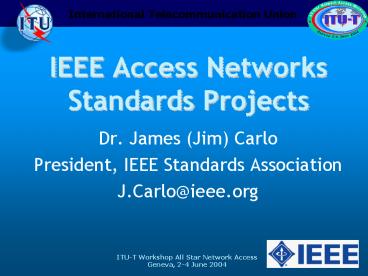IEEE Access Networks Standards Projects - PowerPoint PPT Presentation
Title:
IEEE Access Networks Standards Projects
Description:
Mat Sherman. RECORDING SECY. Bob O'Hara. TREASURER. Bill. Quackenbush. EXECUTIVE ... Broadband Data over Power Lines (BPL) Call for Interest (7June2004, Denver) ... – PowerPoint PPT presentation
Number of Views:43
Avg rating:3.0/5.0
Title: IEEE Access Networks Standards Projects
1
IEEE Access Networks Standards Projects
- Dr. James (Jim) Carlo
- President, IEEE Standards Association
- J.Carlo_at_ieee.org
2
Key IEEE Areas
- IEEE 802 Standards (IEEE Computer Society)
- IEEE 802 is the Overall Sponsor Committee (Paul
Nikolich Chair) - Each Working Group is called a dot
- IEEE 802.3, IEEE 802.11
- Multiple projects within each dot
- Wired Access
- Wireless Access
- Power Society Call for Interest on PBL
3
IEEE 802 ORGANIZATION
802.21Media IndependentHandover Ajay Rajkumar
4
WIRELINE ACTIVITIES
- 802.1 Overview and architecture
- Bridging, architecture, addressing, security
(liaison with IETF) - 802.3 CSMA/CD Ethernet
- LANs faster, faster, faster 10/100/1000/10000Mb
ps fiber/copper - Ethernet in the First Mile
- Smallerbackplane Ethernet
- 802.17 Resilient Packet Ring
- Metropolitan Area Networking
5
IEEE 802.3 Update
- .3ah Ethernet in the First Mile (EFM)
- Extends Ethernet to Access Market
- Final Balloting Underway
- .3an 10GBASE-T
- Standards Project Underway
- 10Gb/s on FDDI-Grade MM Fiber SG
- Backplane SG
- Congestion Management SG
- Ethernet to provide differentiated service and
reduce frame drop
6
10Gbps Ethernet Benefits
- Bring Ethernet cost model to 10 Gbps networks
- Scale MAN LAN backbones
- Aggregates 1 GbE
- Leverages 250 million Ethernet ports
- Supports all services
- Supports local, metro and wide area in one
seamless network - Compatibility with the installed base of SONET
OC-192c / SDH VC-4-64c
7
Multiple Types of Completed IEEE 802.3 10 Gbs
Fiber Ethernet
8
10 GE Transceivers (PMDs)
TARGET
9
IEEE 802.3 10 GbE Task Force UTP Copper
Objectives Support operation over
4-connector structured 4-pair, twisted-pair
copper cabling for all supported distances and
Classes Links of At least 100m on 4-pair
Class F balanced copper cabling At least 55 m
to 100 m on four-pair Class E balanced copper
cabling
10
IEEE 802.17 Resilient Packet Ring
- Use Fiber Optic Rings for transfer of data
packets at rates scalable to many gigabits per
second. - Application for Local, Metropolitan and Wide Area
Networks - Base Standard Completed
11
WIRELESS ACTIVITIES(1)
- 802.11 Wireless Local Area Networks
- 100meters coverage
- Unlicensed in 2.4GHz and 5GHz bands
- 802.15 Wireless Personal Area Networks
- 10meters coverage
- Unlicensed in 2.4GHz and 5GHz bands
- 802.16 Fixed Broadband Wireless Access
- 1000 meters coverage
- Unlicensed and licensed frequencies
- 2-11GHz and 10-66GHz bands
12
IEEE 802.11 Projects
- 2.4GHz Band Wireless
- .11b (11Mbps) DSSS PHY
- .11g (54Mbps) PHY
- 5 GHz Band Wireless
- .11a 54Mbps OFDM PHY
- .11h Spectrum Management
- Enhancements
- 11.e Quality of Service
- 11.i More Robust Security
13
IEEE 802.15 ProjectsWireless PAN
- 15.1 Bluetooth PHY and MAC
- 15.2 Coexistence with 11
- 15.3 Higher Rate WPAN up to 100Mbps
- 15.4 Lower Rate WPAN for very low power
operation - 15.5 Mesh Networking Technology
14
IEEE 802.16 ProjectsWireless LAN
- .16 Basic Air Interface
- MAC PHY (10-66GHz)
- .16Conformance
- Conformance Test Cases
- .16e Enhancement
- Support for Mobile and Fixed
15
WIRELESS ACTIVITES(2)
- 802.18 Radio Regulatory Impact
- ITU-R Interface, US-FCC, etc.
- 802.19 Coexistence Group
- 802.20 Mobile Broadband Wireless Access
- 1000 meter coverage
- Licensed frequencies, under 3.5 GHz
- 802.21 Media Independent Handover
- Develop interface standards to allow handover
across 802 MAC domains and outside 802 MAC
domains
16
IEEE 802 FUTURE DIRECTIONS
- Wireline
- Backplane Ethernet
- Synchronous Ethernet
- Wireless
- WLAN Enhancements
- Mesh networking, fast roaming, vehicular apps
- Unlicensed 54-60 GHzlots of bandwidth
- LAN and PAN applications
17
IEEE International Coordination
- IEC/IEEE Joint Logo Program
- ITU-T Liaison (A.5, A.6)
- ITU-R Membership (REGINTORG)
- ISO/IEC JTC1 IEEE Standards
- ETSI/IEEE Agreement
- Global Portal Web Pages
- Europe, Asia, Americas, Africa
18
Broadband Data over Power Lines (BPL)
- Call for Interest (7June2004, Denver)
- Power, Communications, EMC Societies
- Objectives
- Understand application (home, LV, MV, HV)
- Review the standards that exist already
- Identify regulatory issues
- Determine where potential new standards projects
should be organized within the IEEE































